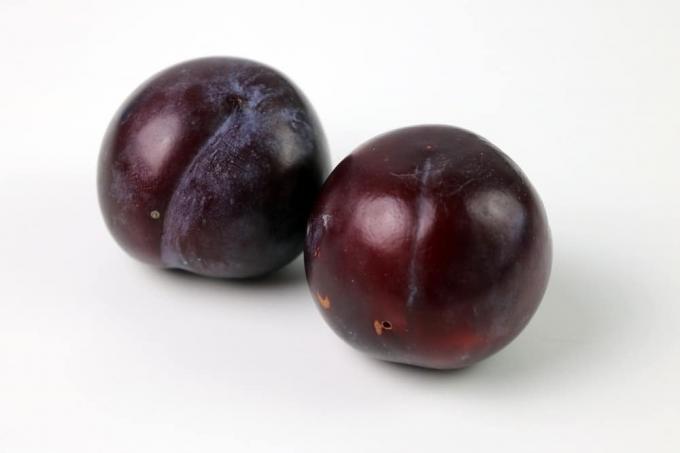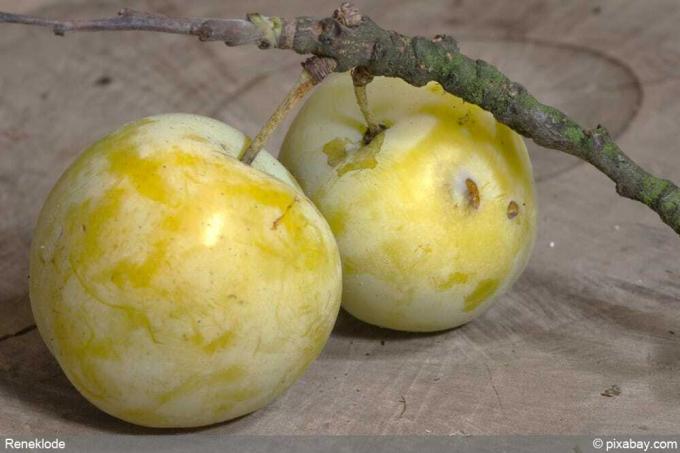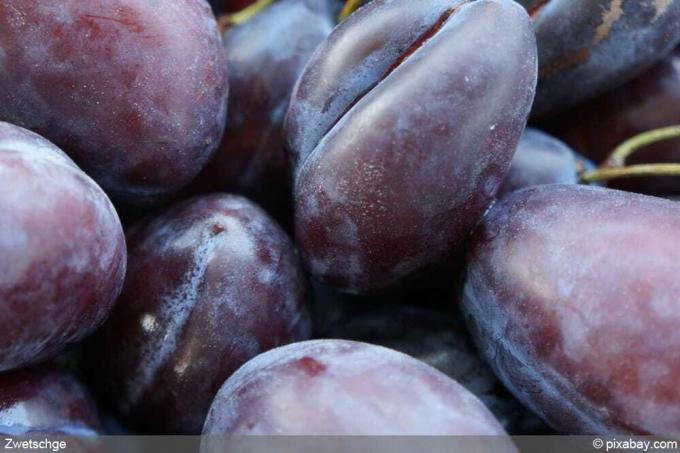

Table of contents
- Plums and damsons - what's the difference?
- Historical plum varieties
- New Varieties
Plum lovers with their own garden have a clear advantage. The delicious summer fruits can only be stored for a limited time, so the selection of varieties on the store shelves is sparse. Own cultivation opens the door wide into the multifaceted world of tempting plum varieties. Ever since ingenious breeders turned their attention to the subject, the diversity has clearly picked up speed. This selection introduces you to 20 old and new plum varieties.
Plums and damsons - what's the difference?
The plum (Prunus domestica) is a subspecies of the genus Prunus with seven subspecies, from which more than 2,000 varieties have emerged. Plums are also one of the subspecies, such as noble plums, also known as greengages, mirabelle plums or oat plums. Due to the rich variety of varieties, the borders are now fluid. Nevertheless, from a horticultural and culinary point of view, the following differences between plums and damsons can be noted:
Plum, noble plum, greengage
- around
- without fruit seam
- difficult to remove stones
- juicy
- more susceptible to Sharka infections
Plum, plum, rare plum
- elongated
- with fruit seam
- good stone dissolving
- less juicy
- tolerant to Sharka infections

Looking at the individual attributes, it becomes clear why plums are often used to prepare compotes and jams. Plums are better for the fruity cake topping. They all taste fresh off the tree.
Historical plum varieties
Count Althan's Greengage
Since 1850, the noble plum has delighted people with its golden-yellow flesh under a blue-red, blood-red skin when fully ripe. Gourmets among home gardeners love this old variety because the balanced acidity promises a sophisticated taste experience with a sweet and spicy aroma.
- Ripeness for picking: late August to early September
- Pollinator variety required
Wangenheim early plum
The historic plum variety has been an integral part of every elite selection since 1840. This is hardly surprising in view of their outstanding properties. Vigorous even in rough locations, resistant to diseases and self-fertile, the fruit tree meets the high demands of private gardeners. The round, dark violet-blue fruits are not only a feast for the eyes, but also make the heart beat faster with their fruity-sweet taste.
- Ripeness for picking: late August to early September
- self-fertile
Oullins Greengage
This plum plum provides convincing proof that yellow-colored fruits taste just as sweet and delicious as their blue-violet counterparts. The noble variety found its way into French farmhouses and monastery gardens as early as 1850, not least because it is ready for harvest from mid-August. Thanks to a firm skin, the proven plum variety keeps a few days longer than soft-skinned greengage.
- Ripeness for picking: mid-August to early September
- self-fertile
Tip:
Smart home gardeners always associate their favorite plum variety with a pollinator variety, even if it's described as self-fertile. In any case, the yield and the quality of the fruit benefit from this horticultural move.
Queen Victoria
As befits a royal variety, 'Königin Viktoria' trumps other fruits in many respects. The yellow plums are very large and gleam on the sunny side in a magnificent blue-red to light violet. The yellow-colored flesh is wonderfully juicy, aromatic and stone-removing. From a horticultural point of view, the noble plum is one of the most productive varieties, so that it has had a regular place in the orchard since 1844. Since it is primarily suitable for fresh consumption, enjoyment is reserved for the home gardener and his family.
- Ripeness for picking: mid-August to mid-September
- self-fertile

Anna Spaeth
When Anna Späth discovered the seedling in 1870, it was the starting signal for a success story that continues to this day. If a plum cake tastes particularly good, the baker usually topped the dough with this old plum variety. Even the dark blue skin promises fruity pleasure, which the yellow-green flesh holds. Home gardeners appreciate the high tolerance to Sharka infections and a remarkable resistance to fruit rot.
- Ripeness for picking: late September to early October
- Pollinator variety required
Big Green Greengage
An old plum variety of superlatives comes under the unspectacular name 'Big Green Greengage'. The classic has conquered the hearts of gardeners in southern and western Europe since 1490 and has not disappointed to this day. The large, green-yellow fruits impress with their juicy, medium-firm flesh, which tastes sugary-sweet and yet spicy. Fresh from the tree or from the jar, the honey-sweet vitamin bomb is popular with young and old. As a good source of pollen, the noble plum is one of the best pollinators for the home garden.
- Ripeness for picking: mid-August to mid-September
- Pollinator variety required
Big house plum
The big house plum lives up to its name, both in terms of its majestic growth and the huge, blue fruits. For generations of home gardeners, this ancient variety has been and still is the first choice when planting a plum tree. Thanks to the loose, spacious arrangement of the branches, the historic plum variety is ideal for trellis training. The sweet, aromatic pulp is good at removing stones. Thanks to a firm shell, you can store your harvest for up to 2 weeks, provided it hasn't been eaten by then.
- Ripeness for picking: end of August to mid/end of September
- self-fertile
Early fertile
A spring plum, as it should be, has been an integral part of the orchard since time immemorial under the name 'Early Fertile'. The small, blue fruits contain the typical plum aroma. The golden-yellow flesh easily detaches from the stone, which the housewife appreciates when preparing it. As a sweet fruit, the delicate plums are very popular with children. Home gardeners still choose the 'Early Fertile' because it has high and regular yields despite its medium vigour.
- Ripeness for picking: early to late August
- Pollinator variety recommended
Tip:
Even premium varieties are not immune to the plum sawfly (Hoplocampa flava). The 5 to 6 mm small pests are up to mischief during the flowering period. Maggot-infested fruits are the unsavory result. White sticky traps, glue rings and protective nets have proven to be very effective for ecological control.
Ersinger's early plum
Do you still have a sunny spot in the lee with sandy-loamy soil in your garden? Then this is the ideal location for the traditional plum variety from 1890. Where the framework conditions are right, the tree carries a sweet load of countless fruits that can weigh up to 40 grams. Whether straight from the tree, as a compote, jam or cake topping, 'Ersingers Frühzwetsche' makes a tasty contribution to the summer menu.
- Ripeness for picking: mid-July to early August
- Pollinator variety required
Bühler early plum
early 20th At the beginning of the 19th century, a plum variety caused a sensation that quickly found its way onto the list of the best fruit varieties in Germany. The magnificent specimen was discovered in Kappelwindeck near Bühl. The name of the breeder could never be determined. The blue, thick fruits are still popular in home gardens today. Every year in September, the 'Bühler Zwetschgenfest' pays homage to the historic variety. The sweet and sour fruits on yeast dough with crispy butter crumbles are a real treat.
- Ripeness for picking: late August to mid-September
- self-fertile
The Czar
The historic plum variety is a welcome guest in private meadow orchards, because the gardener enjoys growing and caring for it. 'The Czar' is of no interest to commercial fruit growers because it can only be stored for a few days. This increases the attractiveness for home gardeners, because they have the privilege of refreshing themselves with the juicy, sweet and sour flesh fresh from the tree.
- Ripeness for picking: early to late August
- self-fertile
New Varieties
Cocoa's beauty
In the race for the best baking plum, 'Cacaks Schöne' takes a top spot in the ranking. As part of breeding, special attention was paid to important attributes such as juicy flesh, stone removal, large fruit and full-bodied. The dark blue fruits are very popular with bakers as the ideal cake topping. In addition, the plums can be used to prepare delicious compotes and aromatic jams. The wishes of the house gardener also flowed into the work of the breeders. The new variety impresses with its high site tolerance, reliable yield and low maintenance requirements.
- Ripeness for picking: mid-August to mid-September
- self-fertile

Tegera
If you don't want to wait until mid-August, add 'Tegera' to the planting plan. Already two weeks before 'Cacaks Schöne', the new variety gives you a lush harvest for fresh consumption and as a cake topping. Dark blue, the medium-sized plums dangle promisingly on the tree and exude a pleasant scent. A downer for the interested home gardener is the low Sharka resistance, so cultivation in endangered regions is not advisable.
- Ripeness for picking: late July to mid-August
- self-fertile
yoyo
A high Sharka resistance paired with a rich fruit load make the innovative 'Jojo' an interesting variety for private and commercial gardeners alike. The new breed is therefore listed in the variety recommendations of the Bavarian State Institute for Viticulture and Horticulture. The large fruits de-stone well and have a firm, sweet flesh. It is important to note the very early flowering period from March, so this plum variety is primarily recommended for warm locations with no risk of late frost.
- Ripeness for picking: early to late September
- self-fertile
herman
Are you looking for a plum variety that you can harvest as early as mid-July? Then we would like to recommend the new breed 'Herman' to you. The dark blue, wonderfully fragrant plums make up for their small size with a juicy, sweet and sour flesh that is easy to remove from the stone. The good Sharka resistance contributes to the fact that the new variety is also highly valued in high-yield cultivation.
- Ripeness for picking: early to mid-July
- self-fertile
Haganta
'Haganta' is characterized by fruits of record-breaking size. A plum weighs up to 80 grams. The new breed is recommended for the home garden, not least because of its low susceptibility to the dreaded Sharka disease. Already in the second year after planting, this variety gives you the first full harvest baskets. The fruits turn blue very early, so the gardener should be careful not to start harvesting prematurely.
- Ripeness for picking: mid to late September.
- self-fertile
Hanita
Combine 'Hanita' with 'Haganta' and the dream team of modern plum varieties will thrive in your orchard. With its fruits weighing up to 50 grams, high yield and robust Sharka resistance, 'Hanita' has established itself as one of the most popular varieties within a few years. Although declared as self-fertile, both breeds benefit each other in terms of taste and yield. Wait until the fruit has turned dark blue before harvesting, because the right taste only develops when it is fully ripe.
- Ripeness for picking: mid-August to early September
- self-fertile

Aprimira
If you are in the mood for a new, unusual variety, 'Aprimira' comes into play. As a natural cross between Mirabelle and plum, the novelty has some outstanding properties to offer. The yellow-orange skin shines with red-purple cheeks. The orange flesh has a high sugar content, which produces a honeyed flavor. Although Aprimira is commercially referred to as apricot mirabelle, the Geisenheim Research Institute expressly points out that apricot pollen or seeds are not part of this variety. Anyone who tastes an Aprimira will not perceive the slightest hint of apricot aroma. Rather, the pulp caresses the palate with a mixture of Mirabelle plum and plum aroma.
- Ripeness for picking: mid to late August
- self-fertile
opal
This favorite variety brings color to the garden with red-violet plums and sweet pleasure to the table. Predestined for fresh consumption, the new variety is reserved for home gardeners who prefer to eat the delicious fruit fresh. Since the golden-yellow pulp easily separates from the stone, the morning plum harvest in the hands of the housewife is transformed into a delicious cake for the coffee table by the afternoon. The yield is at such a high level that in good years additional thinning of the crown is required so that the sweet load does not break the branches. House gardeners are happy to put up with the work because they don't have to worry about the dreaded Sharka infection with this new plum variety.
- Ripeness for picking: early to late August
- self-fertile
Geisenheim Top
The ideal plum variety for the small garden scores with a slender shape, white-pink fairy tale flowers and steel-blue summer fruits. Thanks to the late flowering time in April, the successful breeding avoids late frosts. The result is a bountiful early fall harvest that's well worth the wait for her delicious aroma. In addition to space-saving growth, the breeders attached great importance to robust resistance to diseases and pests.
- Ripeness for picking: mid to late September
- self-fertile
 garden editorial
garden editorial I write about everything that interests me in my garden.
Learn more about fruit types

Orange Tree: Care | 17 tips for an orange tree
Orange trees are conquering more and more terraces, balconies and conservatories. In Germany, they are usually kept in buckets due to the climatic conditions. The small trees are very floriferous and decorative. Under optimal conditions even fruit can be harvested.

Pineapple plant: how to grow a pineapple yourself - instructions
With the remains of a pineapple, the hobby gardener has valuable material to grow this delicious fruit himself. The so-called tuft of leaves is the starting material for this. In addition, the pineapple can also be grown with the help of seeds and Kindel.

Apricot Tree: Care Instructions & Overwintering | Is he hardy?
The apricot tree beautifies every garden, especially with its fragrant flowers, which sprout bright white in spring. If everything has been done correctly with care, hibernation and the choice of location, then the garden owner can enjoy sweet fruits at the end of summer.

Bayern-Kiwi Weiki® - planting instructions, care and propagation
Hardy mini kiwis are a hit in private fruit growing. The leading variety is the innovative Bayern-Kiwi Weiki®, which impresses with its gooseberry-sized fruits and majestic growth. This guide will familiarize you with all aspects of professional planting, expert care and successful propagation.

Dwarf fruit tree: growing dwarf fruit in the garden
Everything about the dwarf fruit tree is a few sizes smaller - only the fruit it bears is as big as its conventional brothers. It is therefore ideal for small gardens and for cultivation in tubs. Everything you need to know about growing and caring for dwarf fruit trees can be found here.

Pillar cherry - delicious varieties, plants & instructions for cutting
Hardly anything is more delightful than biting into ripe, juicy sweet cherries in early summer - which you have just picked fresh from the tree yourself. Fortunately, you no longer need a large garden to plant a richly bearing cherry tree. A columnar cherry fits even in the smallest garden - and even on the balcony.


